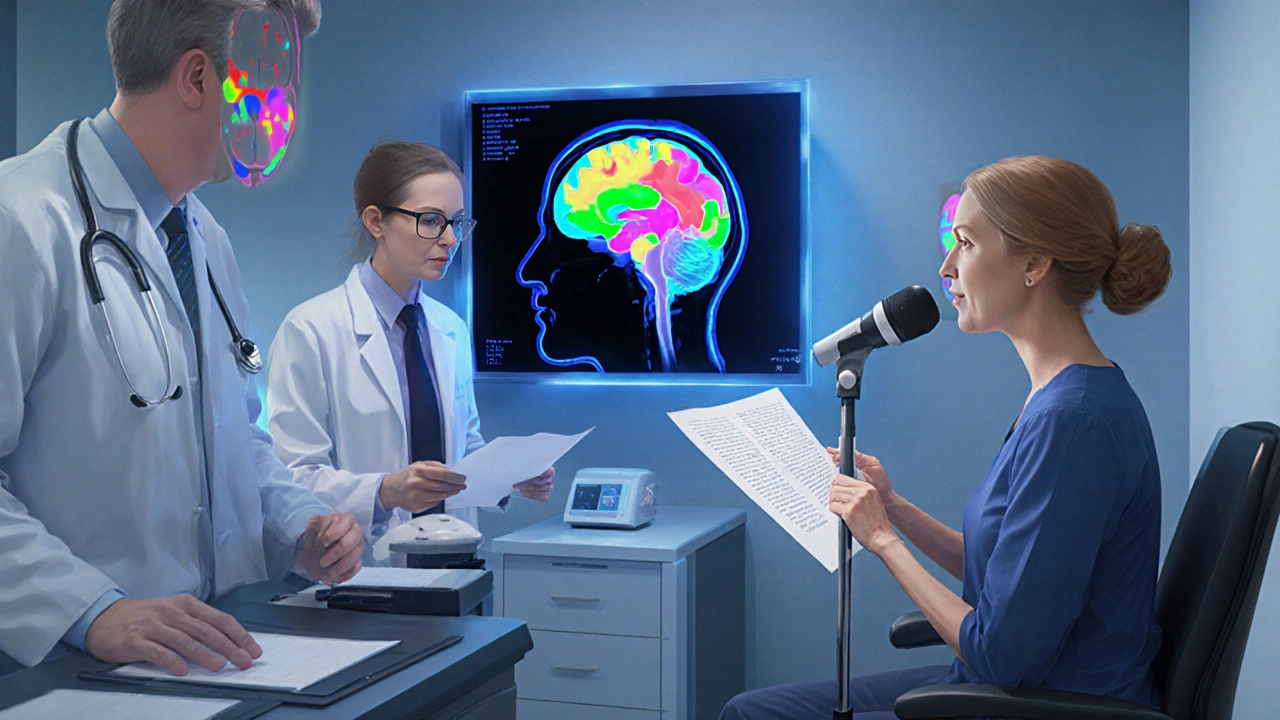Parkinson's disease is a progressive neurodegenerative disorder characterized by dopamine deficiency, motor rigidity, tremor, and bradykinesia. When dopamine levels drop in the basal ganglia, the fine‑tuned control of respiratory and laryngeal muscles that generate speech becomes impaired, leading to a cascade of communication challenges.
Why Speech Falls Apart: The Neuro‑Motor Chain
Speech production relies on three linked subsystems: respiration, phonation, and articulation. In Parkinson's disease, the basal ganglia deep brain structures that modulate movement receive insufficient dopamine, causing slowed or uncoordinated muscle activation. This manifests as reduced breath support, a soft voice (hypophonia), and irregular vocal fold vibration. The same dopamine shortfall also affects the speech motor cortex cortical area that plans speech movements, leading to imprecise tongue and lip motions.
Research from the University of Pennsylvania (2023) reports that patients with a dopamine transporter binding loss of >30% show a 45% drop in average speech intensity. In other words, the brain chemistry directly translates into how loudly and clearly someone can speak.
Typical Speech and Communication Symptoms
- Hypophonia: voice becomes soft, often requiring listeners to lean in.
- Monotone prosody: loss of pitch variation makes speech sound robotic.
- Accelerated or slowed speech rate: bursts of rapid words followed by pauses.
- Dysarthria: slurred or imprecise articulation due to weakened facial muscles.
- Reduced facial expression (masked facies) which compounds the perception of disengagement.
Each symptom chips away at communication effectiveness the ability to convey thoughts and emotions to others, increasing social isolation and lowering quality of life.
How Clinicians Measure Speech Changes
Standardized tools help quantify the impact:
- Unified Parkinson's Disease Rating Scale (UPDRS) - Speech Item scores voice volume, intelligibility, and prosody on a 0‑4 scale.
- Voice Handicap Index (VHI) patient‑reported measure of perceived vocal difficulty, with a threshold >30 indicating moderate impairment.
- Acoustic analysis (e.g., jitter, shimmer, harmonic‑to‑noise ratio) captured via smartphone apps provides objective data for monitoring progression.
These assessments guide treatment intensity and track response over time.
Therapeutic Options: What Works Best?
Speech‑language pathologists (SLPs) typically choose from three evidence‑based approaches. The table below compares core attributes.
| Technique | Primary Goal | Session Length | Evidence Level (2024) |
|---|---|---|---|
| LSVT LOUD intensive voice‑amplification program | Increase vocal intensity & pitch variability | 4×60‑min sessions over 4weeks | Level1 (randomized controlled trials) |
| Traditional Articulation Therapy focus on precise tongue and lip movements | Improve intelligibility of consonants | 2×45‑min sessions weekly | Level2 (cohort studies) |
| Singing Therapy uses melodic singing to train breath support | Enhance breath control & emotional expression | 1×60‑min session bi‑weekly | Level3 (pilot trials) |
Across multiple meta‑analyses, Parkinson's disease speech improvements of 6‑10dB in loudness are most reliably achieved with LSVT LOUD, while articulation therapy better targets consonant clarity. Many clinicians combine approaches to cover the full symptom spectrum.
Technology‑Assisted Communication Aids
When therapy alone cannot restore functional speech, augmentative and alternative communication (AAC) tools step in. Options include:
- Speech‑generating devices (SGDs) that synthesize text‑to‑speech with customizable voice settings.
- Smartphone apps (e.g., VoiceTalk real‑time voice amplification app) that boost volume without distortion.
- Brain‑computer interfaces under investigation for direct neural control of vocal output.
Adopting AAC early-often before severe hypophonia sets in-helps maintain social participation.

Everyday Impact: Quality of Life and Social Interaction
Communication breakdown affects more than conversation; it ripples into work, relationships, and mental health. A 2022 cross‑sectional study of 1,200 Parkinson's patients showed that those reporting communication difficulty as a top concern had a 30% higher odds of depression.
Practical consequences include:
- Withdrawal from group activities because the effort of speaking feels exhausting.
- Misunderstandings at the workplace leading to reduced performance ratings.
- Strain on caregivers who must repeat information or resort to non‑verbal cues.
Addressing speech early can mitigate these downstream effects.
Tips for Caregivers and Clinicians
Effective communication strategies are simple yet powerful:
- Face the person directly; visual cues support comprehension.
- Speak slightly slower and pause often; give the listener time to process.
- Ask the speaker to repeat using the word "again" rather than "what?"-this reduces frustration.
- Maintain a quiet environment to lower background noise.
- Encourage regular voice‑exercise drills; consistency beats intensity.
SLPs often provide a "communication toolbox" that includes cue cards, picture boards, and structured conversation scripts.
Future Directions: Research and Emerging Treatments
Two promising fronts are shaping the next decade:
- Deep Brain Stimulation (DBS) surgical implantation that modulates basal ganglia activity. Early trials (2024) indicate modest improvements in speech timing when targeting the subthalamic nucleus.
- Artificial‑intelligence acoustic monitoring: cloud‑based platforms can flag subtle vocal changes months before clinical scales detect them, enabling pre‑emptive therapy adjustments.
Combining neurostimulation with AI‑guided voice training could eventually personalize treatment intensity to each patient’s evolving neuro‑physiology.
Related Concepts and Next Steps
Understanding speech impact sits within a broader cluster of Parkinson's research, including motor symptom management, cognitive decline, and neuroprotective drug development. Readers may also explore:
- Parkinson's disease and swallowing disorders (dysphagia).
- Non‑motor symptoms such as anxiety and their interaction with communication.
- Exercise programs like treadmill training that indirectly improve breath support for speech.
Delving into those topics rounds out a holistic view of living well with Parkinson's.
Frequently Asked Questions
Why does my voice get softer as Parkinson's progresses?
The loss of dopamine in the basal ganglia weakens the coordination of the respiratory and laryngeal muscles. With less breath support, the vocal folds cannot vibrate with enough amplitude, so the voice sounds quiet (hypophonia).
Can speech therapy really change the disease course?
Therapy does not halt neuronal loss, but it can improve functional communication. Intensive programs like LSVT LOUD have shown sustained increases in volume and intelligibility that last up to two years after training.
What distinguishes LSVT LOUD from regular voice exercises?
LSVT LOUD uses a calibrated decibel target (90dB) and provides immediate feedback via a microphone. Standard exercises often lack that quantitative goal and are delivered at lower intensity.
Is a speech‑generating device covered by health insurance?
Coverage varies by country and plan, but many public health systems list SGDs under assistive‑technology benefits for severe dysarthria. Documentation of a formal speech‑language evaluation is usually required.
How soon after diagnosis should speech therapy begin?
Ideally within the first six months. Early intervention capitalizes on residual motor function and helps establish vocal habits before hypophonia becomes entrenched.


MANAS MISHRA
September 26, 2025 AT 22:06Your overview of speech challenges in Parkinson's is clear and compassionate.
Tom Becker
October 1, 2025 AT 13:12When you look at how the medical establishment pushes its agenda, the truth about Parkinson’s speech therapy gets buried under glossy brochures. The pharma giants quietly fund studies that favor drug‑centric solutions, while the real work of voice training stays on the fringe. It feels like a coordinated effort to keep patients dependent on medication that barely touches the vocal cords. The LSVT LOUD program, for instance, shows dramatic gains, yet insurance companies label it “experimental” and refuse coverage. Meanwhile, the alarmingly low ratings on the Voice Handicap Index get dismissed as subjective whining. I’ve seen patients describe the frustration of shouting just to be heard, and the system turns a blind eye. The rise of AI‑based acoustic monitoring could be a game‑changer, but only if it isn’t sold to the highest bidder and turned into surveillance. There are whispers that data from these apps will be sold to biotech firms looking to tailor drugs, not to help speech. The deep‑brain stimulation trials hint at modest vocal benefits, but the hype surrounding motor improvements overshadows the subtle speech changes. And let’s not forget the hidden cost of augmentative communication devices that are out of reach for most families. It’s a tangled web of profit, policy, and misplaced priorities that keeps the real voice of patients muted. The community needs to demand transparency and push for broader coverage of evidence‑based therapy. Only then can we break the cycle that lets corporations profit while patients struggle to be heard. The battle for clear speech is a battle for dignity, and we must not let it be silenced by corporate greed. Our voices will echo louder when we stand together against the silence.
Laura Sanders
October 6, 2025 AT 04:19The mechanistic underpinnings of hypophonia are well‑documented; a simple dopamine deficit precipitates the cascade.
Such neurochemical erosion inevitably manifests as reduced vocal intensity, a fact that any competent neurologist cannot ignore.
Jai Patel
October 10, 2025 AT 19:26Let’s shine a bright spotlight on the amazing therapy options that can truly empower those battling Parkinson’s speech challenges! LSVT LOUD isn’t just another program-it’s a vocal boot‑camp that cranks up volume and brings back that lively pitch variation we all love. Traditional articulation therapy fine‑tunes those delicate tongue and lip movements, turning slurred words into crisp consonants. And don’t overlook the magic of singing therapy; the melodic flow builds breath support while letting emotions soar through song. Combining these approaches creates a vibrant toolbox that tackles every facet of communication loss.
Zara @WSLab
October 15, 2025 AT 10:32Keep pushing those voice drills, you’ve got this! 🌟
Randy Pierson
October 20, 2025 AT 01:39Research shows that smartphone‑based acoustic analysis can track jitter and shimmer with impressive precision, offering clinicians real‑time feedback on therapy progress. Integrating these metrics into weekly home practice makes the exercises far more targeted and measurable. This data‑driven approach amplifies the benefits you highlighted, turning good effort into great outcomes.
Bruce T
October 24, 2025 AT 16:46We’ve got a responsibility to make these tech tools accessible, not just hoard them for research labs that line their pockets. If we ignore the inequities, we’re essentially telling patients that their voices don’t matter enough to fund affordable solutions.
Darla Sudheer
October 29, 2025 AT 06:52It’s great to see the community sharing practical tips.
Elizabeth González
November 2, 2025 AT 21:59The ethical dimensions of deploying AI‑driven vocal monitoring demand rigorous scrutiny, particularly regarding consent and data sovereignty. While the technology promises early detection, we must balance innovation with respect for patient autonomy, ensuring that surveillance does not eclipse therapeutic intent.
chioma uche
November 7, 2025 AT 13:06In our country we will not allow foreign tech giants to dictate how we monitor our own citizens’ voices; we will develop homegrown solutions that serve our people first.